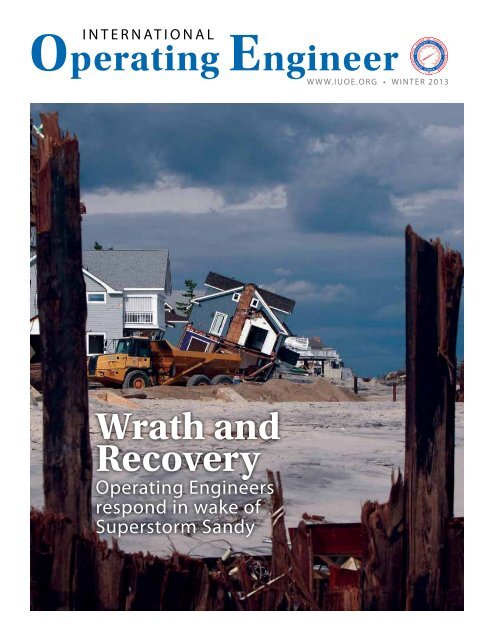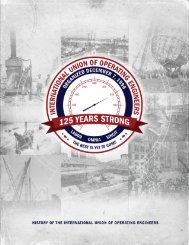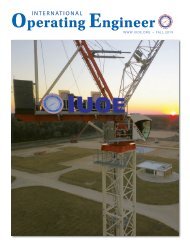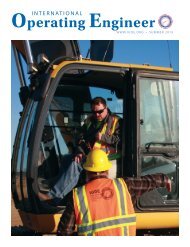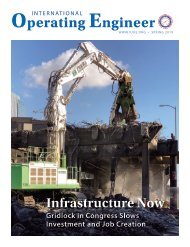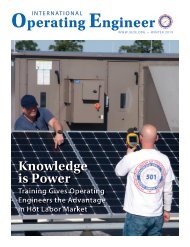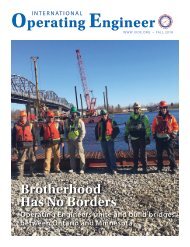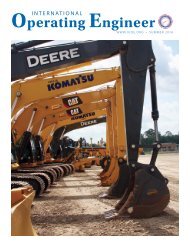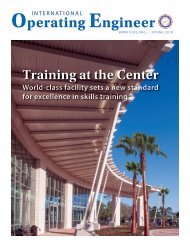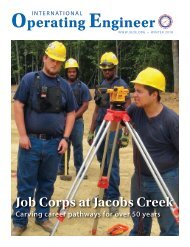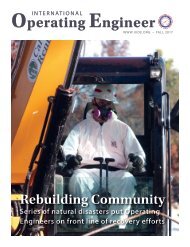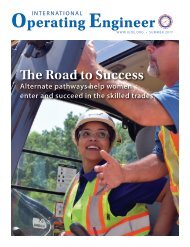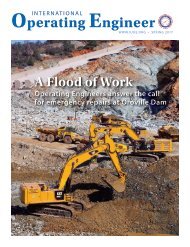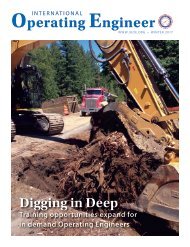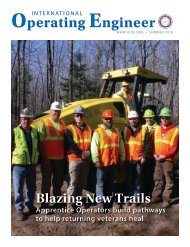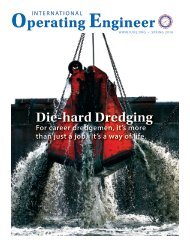Operating Engineer - Winter 2013
The quarterly magazine of the International Union of Operating Engineers.
The quarterly magazine of the International Union of Operating Engineers.
Create successful ePaper yourself
Turn your PDF publications into a flip-book with our unique Google optimized e-Paper software.
i n t e r n at i o n a l<br />
<strong>Operating</strong> <strong>Engineer</strong><br />
www.iuoe.org • WINTER <strong>2013</strong><br />
Wrath and<br />
Recovery<br />
<strong>Operating</strong> <strong>Engineer</strong>s<br />
respond in wake of<br />
Superstorm Sandy
2<br />
international operating engineer
i n t e r n at i o n a l<br />
<strong>Operating</strong> <strong>Engineer</strong><br />
<strong>Winter</strong> <strong>2013</strong> • Volume 156, No. 1<br />
Brian E. Hickey, Editor<br />
Jay Lederer, Managing Editor<br />
08 Our Work: Energy<br />
Threading a gas pipeline under the Hudson River<br />
10 Member Spotlight<br />
Operation Walk Nicaragua: A Reflection of Gratitude<br />
14 Right-to-Work (for less)<br />
What’s at stake as states take aim at unions<br />
16 Wrath and Recovery<br />
Restoring communities in wake of Superstorm Sandy<br />
Departments<br />
05 From the General President<br />
06 Education & Training<br />
12 Politics & Legislation<br />
20 Canadian News<br />
22 HAZMAT<br />
23 Healthcare<br />
24 GEB Minutes<br />
28 In Memorium<br />
[cover] <strong>Operating</strong> <strong>Engineer</strong>s throughout the Northeastern<br />
United States have been part of recovery efforts in the<br />
wake of Superstorm Sandy.<br />
[photo] Tim Larsen/ NJ Governor’s Office<br />
[left] Local 302 members work to complete the Eva Creek<br />
Wind Farm near Healy, Alaska.<br />
[photo] Joe Ebertsch, Michels Wind Energy<br />
WINTER <strong>2013</strong> 3
International <strong>Operating</strong> <strong>Engineer</strong><br />
(ISSN 0020-8159) is published by the:<br />
International Union of<br />
<strong>Operating</strong> <strong>Engineer</strong>s, AFL-CIO<br />
1125 17 th Street, NW<br />
Washington, DC 20036<br />
Subscription Terms - $5 per year<br />
Change of Address - Requests must<br />
be submitted in writing to the IUOE<br />
Membership Department (address<br />
above). Include your new address,<br />
registration and local union number.<br />
POSTMASTERS – ATTENTION:<br />
Change of address on Form 3579<br />
should be sent to:<br />
International <strong>Operating</strong> <strong>Engineer</strong><br />
Mailing List Dept.<br />
1125 17th St., NW, 3rd Floor<br />
Washington, DC 20036<br />
Publications Mail Agreement No.<br />
40843045<br />
Return undeliverable Canadian<br />
addresses to:<br />
2835 Kew Drive<br />
Windsor, ON N8T3B7<br />
Printed in the U.S.A.<br />
International Union of <strong>Operating</strong> <strong>Engineer</strong>s<br />
AFL-CIO<br />
general officers<br />
James T. Callahan, General President<br />
Brian E. Hickey, General Secretary-Treasurer<br />
William C. Waggoner, First Vice President<br />
Patrick L. Sink, Second Vice President<br />
Jerry Kalmar, Third Vice President<br />
Russell E. Burns, Fourth Vice President<br />
Rodger Kaminska, Fifth Vice President<br />
James M. Sweeney, Sixth Vice President<br />
Robert T. Heenan, Seventh Vice President<br />
Daniel J. McGraw, Eighth Vice President<br />
Daren Konopaski, Ninth Vice President<br />
Michael Gallagher, Tenth Vice President<br />
Greg Lalevee, Eleventh Vice President<br />
Terrance E. McGowan, Twelfth Vice President<br />
Louis G. Rasetta, Thirteenth Vice President<br />
Mark Maierle, Fourteenth Vice President<br />
trustees<br />
John T. Ahern, Chairman<br />
Kuba J. Brown, Trustee<br />
Bruce Moffatt, Trustee<br />
James T. Kunz, Jr., Trustee<br />
Joseph F. Shanahan, Trustee<br />
engineers action resPonse netWorK<br />
Because elections matter<br />
Make your voice heard • Register for EARN today<br />
www.iuoe.org<br />
4<br />
international operating engineer
From the General President<br />
A look back on the way forward<br />
A new year brings opportunities and challenges<br />
[James T. Callahan]<br />
At the beginning of each New<br />
Year, many of us resolve to make changes<br />
that will improve our lives, whether<br />
it is personally or professionally. These<br />
decisions and the choices we make going<br />
forward benefit from experiences<br />
we have gained. This is also true of our<br />
union. So before looking ahead, let’s<br />
look at what we can take away from the<br />
past year.<br />
In the course of one week last fall,<br />
the <strong>Operating</strong> <strong>Engineer</strong>s experienced<br />
both tragedy and triumph. On October<br />
29, Superstorm Sandy unleashed a fury<br />
of wind and water upon the Northeastern<br />
United States not seen in my lifetime.<br />
Homes were shattered and communities<br />
decimated. Over 500 fellow<br />
<strong>Operating</strong> <strong>Engineer</strong>s sustained damage<br />
to homes and vehicles, and many<br />
lost everything.<br />
Despite the overwhelming devastation<br />
and personal loss, thousands of<br />
<strong>Operating</strong> <strong>Engineer</strong>s mobilized, bringing<br />
their skill and training, to assist<br />
rescue crews and utility workers gain<br />
access to homes and communities cut<br />
off by flood waters and buried beneath<br />
sand and debris. Just as quickly, our<br />
locals reached out to members within<br />
the affected areas offering aid, supplies<br />
and a helping hand.<br />
Last year, the IUOE National Charity<br />
Fund paid out over $1.7 million in<br />
claims resulting from the superstorm<br />
and other natural disasters in the Gulf<br />
Coast region. Our locals and many individual<br />
members stepped up to help,<br />
donating close to $500,000 to the Fund.<br />
Our unity is our strength and together<br />
we will rebuild our homes, our communities<br />
and our states.<br />
About a week later, we were buoyed<br />
by news of a completely different<br />
nature. After weeks and months of<br />
hard work in the political campaign<br />
trenches, IUOE members turned out<br />
to vote in large numbers across the<br />
United States and reelected President<br />
Barack Obama. Member volunteers<br />
and union staff on the ground in key<br />
states were also instrumental in increasing<br />
the number of labor-friendly<br />
lawmakers, from both political parties,<br />
to the House and Senate. By doing so,<br />
we sent a message that we stand for a<br />
strong middle class, better wages, quality<br />
healthcare, safer working conditions<br />
and a stronger voice in the workplace<br />
for all Americans.<br />
Although the campaigns have ended,<br />
the real work is just beginning. We<br />
must remain engaged and hold politicians<br />
at every level accountable. Last<br />
year, labor faced some of its fiercest anti-union<br />
attacks from state legislatures.<br />
Most notably, Indiana and Michigan<br />
passed so called “right-to-work” laws.<br />
Let’s be clear, the term “right-to-work”<br />
is a lie. Under these laws workers lose<br />
rights and no work gets created – they<br />
are a cynical attempt to cripple unions<br />
and dismantle collective bargaining.<br />
These laws drive down wages, on average<br />
14%, which damages the overall<br />
economy.<br />
Backed by well funded, ultra-conservative<br />
groups, “right-to-work” bills<br />
and ballot petitions are being introduced<br />
this year in places like Ohio,<br />
Pennsylvania, Missouri, New Hampshire<br />
and even Ontario, Canada. These<br />
attacks provide a vivid reminder that<br />
our enemies will use every opportunity<br />
to roll back our rights and drive down<br />
wages. The IUOE and our locals are<br />
taking proactive steps and partnering<br />
with allies to engage these attacks head<br />
on. We must bring the fight to them<br />
and we will.<br />
A positive carry over from last year<br />
is the economy, which finally started<br />
to show signs of life as work increased.<br />
We appear to have weathered the worst<br />
of the Great Recession and <strong>Operating</strong><br />
<strong>Engineer</strong>s are poised to seize the opportunities<br />
of <strong>2013</strong>. Leading economic<br />
indicators point to steady and continued<br />
growth in the construction industry<br />
as many sectors of our economy<br />
– oil, gas, power generation, housing<br />
and manufacturing – anticipate growth<br />
over the coming decade.<br />
A major priority for IUOE will be in<br />
infrastructure investment. The nation’s<br />
highways, bridges and rail systems<br />
have been neglected and underfunded<br />
far too long. Working in a bipartisan<br />
way, we must make the case for a bold<br />
and sustained commitment. President<br />
Obama made multiple attempts in his<br />
first term and has signaled that he will<br />
continue to do so in his second, even<br />
making mention of it his inaugural address.<br />
We will work with the Administration<br />
to make the case that smart and<br />
strategic investments in infrastructure<br />
are needed right now, both to support<br />
jobs in the short term and to build a<br />
productive economy for the long haul.<br />
So it seems that this year’s to-do<br />
list isn’t any shorter or less meaningful<br />
than those in years past. We will continue<br />
to bring the energy, talent and<br />
resources necessary to create and seize<br />
opportunities for IUOE members and<br />
their families throughout the United<br />
States and Canada. We will stand with<br />
our signatory contractors and companies<br />
to increase market share and work<br />
to bring others on board. We will stand<br />
up to those who wish to roll back workers’<br />
rights and drive down wages. In all<br />
these endeavors, let no one question<br />
our resolve to see the job through.<br />
Best wishes for a safe, healthy and<br />
prosperous New Year.<br />
WINTER <strong>2013</strong> 5
Education & Training<br />
Youth Helping Youth at<br />
Pittsburgh Job Corps Project<br />
The IUOE Job Corps National Training Fund<br />
has again partnered with a local community organization<br />
for a very positive outcome. Sponsored by IUOE Local 66,<br />
the Pittsburgh Job Corps Center successfully completed<br />
major renovations on a project for Hosanna House, a nonprofit<br />
organization aimed to benefit at-risk families and<br />
individuals located in Wilkinsburg, Pennsylvania. The<br />
partnership between the organizations created a positive<br />
Sherwood project could not have been completed. He went<br />
on to say that the assisted value of work that the Job Corps<br />
Program has completed in the past two years at Sherwood<br />
totals well over $300,000.00.<br />
Mr. Haynes pointed out that, clearly, the youth of<br />
Wilkinsburg have benefited from the project, but equally<br />
important was that every Job Corps student who participated<br />
in the first year of the Sherwood project went on to become<br />
members of the Local 66 Apprenticeship Program. In<br />
appreciation of the work donated by the Job Corps students,<br />
Mr. Joseph Dixon, (then) lead instructor for the Job Corps<br />
program in Pittsburgh, was presented with the “Angel of<br />
Hope” award for going above<br />
and beyond in making a<br />
difference in the lives of<br />
young people.<br />
The work at Sherwood,<br />
as well as the positive<br />
cooperation between the<br />
Pittsburgh Job Corps Center<br />
and Hosanna House, will<br />
continue in coming years.<br />
Future plans include<br />
improvements to the storm<br />
water management system,<br />
installation of a deck<br />
hockey rink donated by the<br />
Pittsburgh Penguins, removal<br />
of existing tennis courts<br />
and the redesign of a large<br />
parking area.<br />
change for local youth, along with outstanding training for<br />
future operating engineers.<br />
Hosanna House joined with the Pittsburgh Job Corps<br />
Center’s program to create “Sherwood,” a facility open for<br />
youth of all ages, with a goal of helping them discover and<br />
develop their maximum potential in several aspects of<br />
their lives. Job Corps students worked to demolish many<br />
old on-site structures, construct a large retaining wall to<br />
accommodate the building of a new swimming pool, excavate<br />
and grade the pool area and develop an all purpose activity<br />
field. What makes the Sherwood project quite unique is that<br />
youth looking for change through Job Corps helped create a<br />
facility for youth needing a change at Hosanna House.<br />
Mr. Leon Haynes, Director of Hosanna House, reported at<br />
the Ambassador of Hope Gala held in December 2012, that<br />
without the assistance of IUOE Local 66 and Job Corps, the<br />
[top] Pittsburgh Job Corps members construct a retaining wall at<br />
Hosanna House.<br />
[above, l to r] Hosanna House Director Leon Haynes presents<br />
Joseph Dixon with the “Angel of Hope” award. [photos: J. Dixon]<br />
6<br />
international operating engineer
Local 450’s new Union Hall and<br />
Training Center Dedicated<br />
IUOE Local 450 covers a large geographical portion<br />
of South-Central Texas including Houston, San Antonio,<br />
Austin, and Beaumont, and is heavily involved in the Petro-<br />
Chemical and pipeline industries. Early in 2009, Local 450<br />
began an internal re-structuring process under International<br />
supervision. In August of 2010, the Local conducted an<br />
election which ushered in a new administration headed up<br />
by Business Manager Mark Maher.<br />
Part of the re-structuring process included a 300 acre land<br />
purchase for the site of a new union hall and training center.<br />
The new facilities were dedicated in October by General<br />
President Callahan as part of the festivities enjoyed by Local<br />
450 members and their families.<br />
The new administration, facilities and training program<br />
have proven to be a tremendous benefit to the members and<br />
employers and represent a successful transition of returning<br />
control of the Local 450 back to its membership.<br />
Al Bove Elected to OECP Board of Directors<br />
Albert C. Bove has been elected to the OECP Board<br />
of Directors. Mr. Bove currently serves as Executive Vice<br />
President and Chief <strong>Operating</strong> Officer of AmQuip Crane<br />
Rental LLC headquartered in Trevose, Pennsylvania.<br />
AmQuip Crane Rental is a leading provider of crane rentals<br />
and related services in the United States. With eleven<br />
locations throughout the country, it is one of the nation’s<br />
largest employers of <strong>Operating</strong> <strong>Engineer</strong>s.<br />
Mr. Bove joined AmQuip in 2010 and has over 40 years of<br />
experience in senior management of crane rental companies.<br />
As the former President and CEO of Maxim Crane Works, he<br />
also has extensive experience in managing large multi-depot<br />
crane facilities.<br />
The OECP is a joint labo¬r-management, non-profit<br />
testing entity that has been certifying crane operators<br />
since 2002. The program is managed by a Board of<br />
Directors representing both the International Union of<br />
<strong>Operating</strong> <strong>Engineer</strong>s and signatory contractors from<br />
some of the nation’s largest crane rental companies.<br />
To date, the OECP has conducted over 17,000<br />
written examinations and over 12,000 practical<br />
(hands-on) tests for crane operators from all parts of<br />
the United States. In addition, in 2008 the program was<br />
officially recognized by Federal OSHA as meeting OSHA and<br />
ASME (ANSI) requirements for crane operator competency.<br />
The program is only available to IUOE members in good<br />
standing, thereby ensuring that its efforts and resources are<br />
not contributing to the support of non-union operators or<br />
unsigned contractors.<br />
Any member in good standing meeting the program’s<br />
eligibility requirements can participate in OECP testing<br />
anywhere it is scheduled – even if not a member of the local<br />
where the testing is being conducted. There are no out-ofpocket<br />
expenses for IUOE members to participate in OECP<br />
examinations.<br />
WINTER <strong>2013</strong> 7
Our Work: Energy<br />
<strong>Operating</strong> <strong>Engineer</strong>s Thread Mile-Plus-Long Pipeline<br />
Under Hudson River to Expand Natural Gas Supply<br />
<strong>Operating</strong> engineers joined in a dramatic<br />
maneuver to connect New Jersey and midtown Manhattan<br />
with a 5,400-foot natural gas pipeline 140-feet beneath the<br />
Hudson River.<br />
The connection was a critical piece of Spectra Energy’s<br />
15.5-mile natural gas pipeline extension between Linden, NJ,<br />
through Bayonne, Jersey City and part of offshore Hoboken<br />
to its destination in Manhattan. Portions of the project are<br />
still under construction, which is scheduled for completion<br />
later this year. Spectra Energy (NYSE SE) of Houston, TX,<br />
is replacing and modifying existing facilities in New Jersey,<br />
New York and Connecticut.<br />
“Expanding pipeline capacity is intended to reduce<br />
bottlenecks and fill the demand for clean, reliable energy in<br />
the most densely populated areas of the country,” said John<br />
Rocco, Lead <strong>Engineer</strong> who works for contractor Henkels and<br />
McCoy.<br />
The Hudson River crossing followed months of<br />
preparation. The length of pipe needed to span the width of<br />
the river required approximately 135 forty-foot sections to<br />
be welded together, x-rayed to verify integrity of each joint,<br />
then doped. Each weld required a minimum of three hours,<br />
according to Rocco.<br />
Five thousand-foot lengths were assembled. A convoy of<br />
15 side-booms transported each thousand-foot section along<br />
busy 18th Street in Jersey City, parallel to the Hudson County<br />
Light Rail line on the border with Hoboken. At the river’s<br />
edge, the pipe was handed off to six lattice cranes positioned<br />
on barges in the river.<br />
Crane operators hoisted the pipe into an arch and<br />
guided it down to the water, where it was connected to the<br />
drillhead that had burrowed across from Manhattan. Once<br />
connected, it was slowly “pulled back” beneath the river. As<br />
each thousand-foot section was pulled in, a new section was<br />
[L to R] Fred Gear, Adam Snover, Billy<br />
Gebhardt, John Rocco, Greg Lalevee<br />
and Paul Izzo.<br />
8<br />
international operating engineer
It took 15 sidebooms, six cranes, a flotilla of tugboats and<br />
barges and an army of <strong>Operating</strong> <strong>Engineer</strong>s from 13 IUOE locals<br />
throughout the country. Together, they snaked a mile-plus-long<br />
Spectra Energy natural gas pipeline safely across the bottom of the<br />
Hudson River, from Jersey City to midtown Manhattan.<br />
welded to it at the river’s edge until the entire 5,400 feet was<br />
together. The pullback reached the Manhattan side over a<br />
two-day period and was connected there.<br />
“This achievement is a testament to the value of the<br />
extensive pipeline training we provide our members through<br />
our Local and through our International,” said Greg Lalevee,<br />
Business Manager of IUOE Local 825.<br />
“One day before the pullback was scheduled, we were<br />
asked to assemble an additional 36 engineers to take part,”<br />
said Lalevee. “Even on that short notice, we brought together<br />
an experienced team and integrated them seamlessly into<br />
the core group. In the busiest, most densely populated areas<br />
of the country, we executed this task flawlessly, safely and on<br />
schedule.”<br />
IUOE <strong>Operating</strong> <strong>Engineer</strong>s from around the country<br />
participated, including Local 3 of Alameda, CA; Local 4 of<br />
Medway, MA; Locals 14 and 15 of New York City; Local 49 of<br />
Minneapolis, MN; Local 101 of Kansas City, MO; Local 137 of<br />
Briarcliff Manor, NY; Local 139 of Pewaukee, WI; Local 147 of<br />
Norfolk, VA; Local 178 of Fort Worth, TX; Local 624 of Jackson,<br />
MS; Local 627 of Tulsa, OK; and Local 965 of Springfield, IL.<br />
The project was approved by the Federal Energy<br />
Regulatory Commission (FERC) earlier in 2012 to transport<br />
new, critically needed natural gas supplies to high-demand<br />
areas of northern New Jersey, New York City and Connecticut.<br />
Local 825 has become known for its pipeline skills and<br />
experience during the Millennium pipeline in 2007, which<br />
connected Independence in Steuben County, NY, to Buena<br />
Vista in Rockland County, NY, to help meet the energy needs<br />
of Northeast markets.<br />
[story & photos] Local 825/Bill Carlos, Avow Communications<br />
WINTER <strong>2013</strong> 9
Member Spotlight<br />
In October 2012, around 60 medical professionals from Winnipeg and Los Angeles traveled to<br />
Nicaragua with Operation Walk, an organization that offers knee and hip replacements free of<br />
charge to people in North America and in developing nations. Clinical <strong>Engineer</strong>ing Technologist<br />
and IUOE Local 987 member Tabatha Roper was there. This is her personal account.<br />
Operation Walk Nicaragua<br />
A Reflection of Gratitude<br />
[above] Tabatha Roper (back row, fifth from right) stands with the Operation Walk Nicaragua team in front of Dr. Roberto Calderon hospital<br />
in Managua, Nicaragua. [right] A makeshift wheel chair. [far right] Roper gets instruction from a member of Operation Walk Los Angeles<br />
on how to operate a sterilizer. [story & photos] Tabatha Roper/IUOE Local 987<br />
10<br />
international operating engineer
As I stood in front of the Dr. Roberto Calderon Hospital<br />
in Managua, Nicaragua, I couldn’t help but compare it with<br />
the medical facilities in my home town of Winnipeg, Canada.<br />
The one-story, green plaster building was much smaller than<br />
any of the community hospitals we have. It had many of the<br />
same departments as a North American facility, only in a<br />
fraction of the space. A room that would normally house four<br />
patients housed eight. There were no linens or pillows on the<br />
beds unless the patients brought them from home. Many<br />
patients lay on bare mattresses, and visitors brought in their<br />
own lawn chairs labelled with their names. There was also<br />
no air conditioning on the wards and, with temperatures in<br />
the mid to high 30sC (90sF), it made for a very different work<br />
environment.<br />
Still, the ingenuity they demonstrate<br />
is impressive, especially the wheelchairs<br />
fashioned out of plastic lawn furniture.<br />
This was true back-to-basics medicine.<br />
Some of the people seeking treatment are in far worse<br />
shape than we’d ever see in Canada, because they’re<br />
conditions had gone untreated for so long. Some had to<br />
be helped in by family members, and some of them hadn’t<br />
walked in years. They were very polite and grateful for the<br />
treatment they were about to receive.<br />
A lot of the equipment is ancient. Some of the adjustable<br />
patient beds are rusted or seized into a permanent position. In<br />
most cases, the medical gear we discard or retire in Winnipeg<br />
is in better shape. Still, the ingenuity they demonstrate is<br />
impressive, especially the wheelchairs fashioned out of<br />
plastic lawn furniture. This was true back-to-basics medicine.<br />
There was one patient who had been unable to walk for the<br />
last ten years. He was so excited to be mobile again that, two<br />
days after surgery, the physiotherapists had to remind him<br />
to slow down while walking down the hall during exercises.<br />
All in all it was hard work, but absolutely worth it. Over<br />
the course of five days in October, the team performed 49<br />
knee replacement surgeries on 38 patients. All the patients<br />
spoke about what we gave them, but in the end it was<br />
immeasurable what they gave to us. I feel so grateful to have<br />
been a part of this experience.<br />
Operation Walk Missions are 100% funded by the<br />
generosity of donors to the cause. On behalf of Operation<br />
Walk Winnipeg, Dr. Roberto Calderon Hospital and the<br />
patients, I would like to express my most heartfelt thanks.<br />
Your donations have done wonders. I would also like to<br />
thank IUOE Local 987 for their generous gift to this mission.<br />
Thanks to all who gave and participated!<br />
WINTER <strong>2013</strong> 11
Politics & Legislation<br />
Election Season Comes to a Close, Now the Work Begins<br />
Barack Obama was sworn in<br />
for a second term as President of the<br />
United States on January 21, <strong>2013</strong>, after<br />
winning the November election with<br />
over 51% of the popular vote. He is the<br />
only President to garner over 50% twice<br />
since Dwight D. Eisenhower. Obama’s<br />
opponent, Mitt Romney, received 47%<br />
of the popular vote.<br />
Despite persistent high<br />
unemployment and a sluggish<br />
economic recovery from the Great<br />
Recession, President Obama won<br />
a commanding Electoral College<br />
victory, 332-206. The Obama-Biden<br />
ticket surprised many observers<br />
by soundly defeating Mitt Romney<br />
and his Republican running mate,<br />
Representative Paul Ryan.<br />
The IUOE endorsed the Obama-<br />
Biden ticket for re-election. The<br />
President’s support for prevailing<br />
wages, collective bargaining and<br />
workers’ rights, as well as investing in<br />
all facets of America’s infrastructure,<br />
led to that support. Commenting on<br />
the union’s endorsement, General<br />
President Callahan said, “We have<br />
never doubted the President’s<br />
commitment to creating good jobs.”<br />
Mitt Romney also helped make it<br />
a clear choice. As Romney received<br />
the endorsement of the intensely<br />
anti-union Associated Builders and<br />
Contractors, he declared that on “day<br />
one” he would prohibit Project Labor<br />
Agreements, try to end Davis-Bacon<br />
prevailing wages, and lead the charge<br />
for a national “right to work” law. The<br />
contrast could not have been sharper<br />
on key bread-and-butter issues for<br />
<strong>Operating</strong> <strong>Engineer</strong>s. While the IUOE<br />
has a number of solid Republican<br />
supporters in Congress, far too many<br />
Republicans think like Mitt Romney<br />
when it comes to core labor issues.<br />
In other federal elections,<br />
Democrats added seats in both<br />
chambers of Congress. Senate<br />
Democrats picked up two additional<br />
seats, creating a 55-45 majority. While<br />
Republicans maintained their majority<br />
in the House of Representatives,<br />
Democrats added eight seats, making<br />
it 234-201, after vacancies are filled.<br />
The challenge now becomes<br />
keeping our elected officials<br />
accountable, including the President<br />
of the United States. “Electing IUOEfriendly<br />
politicians to office simply is<br />
not enough. We need to be vigilant<br />
throughout the year, developing<br />
relationships and making our voices<br />
heard from the halls of Congress to<br />
city halls,” stated General President<br />
Callahan.<br />
The Legislative Year Ahead<br />
The 113th Congress (<strong>2013</strong>-2014)<br />
will have a full agenda of IUOE<br />
legislative priorities. After passage of<br />
a 27-month highway bill in summer<br />
2012, Congress will again be faced with<br />
enactment of a long-term funding bill<br />
for transportation. The current law,<br />
called Moving Ahead for Progress in<br />
the 21st Century or MAP-21, expires at<br />
the end of September 2014.<br />
The Highway Trust Fund – the lock<br />
box for federal gas-tax revenue, which<br />
must be invested in the nation’s roads,<br />
bridges, and transit systems – is quickly<br />
running out of money due to increased<br />
fuel efficiency and the growth in<br />
alternative-fuel vehicles. Finding<br />
a long-term solution to the United<br />
States’ transportation infrastructure<br />
crisis is absolutely necessary. The<br />
Highway Trust Fund will begin the<br />
2014 fiscal year in a $14-billion hole.<br />
12<br />
international operating engineer
The competitiveness of the nation and<br />
the livelihoods of <strong>Operating</strong> <strong>Engineer</strong>s<br />
simply cannot sustain a cut to this<br />
program.<br />
Other legislation to rebuild<br />
America’s infrastructure will also be<br />
on the congressional agenda. The<br />
Water Resources Development Act<br />
– legislation that guides the nation’s<br />
investment in ports and waterways –<br />
also requires reauthorization. In fact,<br />
it is years overdue. Committee leaders<br />
in the Senate appear ready to advance<br />
legislation early in the first session of<br />
Congress, though substantial obstacles<br />
remain. The law to renew the federal<br />
government’s program to assist local<br />
governments in financing water and<br />
sewer systems is 15 years overdue.<br />
The Clean Water Act-State Revolving<br />
Fund provides low-interest loans and<br />
other assistance to municipalities, but<br />
Congress has failed to renew the law<br />
since the late ‘80s, except on a stop-gap<br />
basis.<br />
2012 Political Program:<br />
Building Power for <strong>Operating</strong> <strong>Engineer</strong>s<br />
Thousands of <strong>Operating</strong><br />
<strong>Engineer</strong>s across the United States<br />
engaged in the hard work of electing<br />
IUOE-friendly politicians, whether<br />
they were Republicans or Democrats,<br />
to city councils, state legislatures,<br />
Congress, and the White House. IUOE<br />
members turned out to vote in record<br />
numbers. In addition, thousands of<br />
IUOE members knocked on doors,<br />
made phone calls, passed out literature,<br />
and talked with their friends, family<br />
members, and co-workers about the<br />
issues that matter most to <strong>Operating</strong><br />
<strong>Engineer</strong>s and the middle class.<br />
“I couldn’t be more proud of<br />
the work that <strong>Operating</strong> <strong>Engineer</strong>s<br />
did in 2012 to elect worker-friendly<br />
politicians,” said General President<br />
Callahan. “Winning elections is not<br />
all fun and games. It’s a lot of hard<br />
work, and the job of building power for<br />
<strong>Operating</strong> <strong>Engineer</strong>s is never done.”<br />
Coordinating closely with local<br />
unions, the International Union<br />
focused its field efforts on tough U.S.<br />
Senate races and other key electoral<br />
fights in four states. International<br />
field staff joined local unions’<br />
political operations in Massachusetts,<br />
Michigan, Nevada, and Wisconsin.<br />
The IUOE-endorsed Senate<br />
candidate won in three out of four races.<br />
The United States Senate welcomed<br />
Tammy Baldwin from Wisconsin and<br />
Elizabeth Warren of Massachusetts.<br />
Senator Debbie Stabenow, of Michigan,<br />
also won reelection to her third<br />
term. Unfortunately, IUOE supporter<br />
Shelley Berkley lost her effort to unseat<br />
incumbent Senator Dean Heller in<br />
Nevada.<br />
[p. 14, top] President Obama, Vice President<br />
Biden and their families celebrate on<br />
election night. [photo] AP/Chris Carlson<br />
[p. 14, left] Local 4 Business Manager and<br />
International Vice President Louis Rasetta<br />
and newly elected Sen. Elizabeth Warren<br />
(D-MA). [photo] IUOE Local 4<br />
[top] Using his GPS, Local 3 retiree Joel<br />
Lanstra gets ready to drop fliers on<br />
doorsteps for Obama in Nevada.<br />
[photo] IUOE Local 3<br />
[above] Local 3 members demonstrate<br />
their opposition to California’s Proposition<br />
32. [photo] IUOE Local 3<br />
WINTER <strong>2013</strong> 13
Politics & Legislation<br />
Michigan’s “Right-to-Work” Law Confers No Rights and Creates No Work<br />
Right-to-work laws confer no<br />
rights and create no work — they’re<br />
an attempt by employers and the<br />
politicians they bankroll to keep<br />
workers unorganized, unrepresented<br />
and underpaid.<br />
Nevertheless, the lame-duck<br />
Republican legislature in Michigan<br />
recently passed a so-called right-towork<br />
law, which was instantly signed<br />
by the governor. Here’s why that was<br />
a big mistake for Michigan’s<br />
workers and economy.<br />
Right-to-work proponents<br />
claim to be fighting “forced<br />
unionism.” But under current<br />
federal law, no worker is<br />
required to join a labor union.<br />
That same federal law,<br />
however, requires unions to<br />
represent everyone at a given<br />
workplace — member or not —<br />
in contract negotiations and in<br />
settling work-related problems<br />
with employers.<br />
Since it’s obviously not<br />
fair for dues-paying union<br />
members to pick up the tab for<br />
services provided to nonunion<br />
members, nonmembers are<br />
sometimes charged a service,<br />
or “agency,” fee. None of the<br />
money collected in agency fees<br />
can be used for political, social<br />
or any other activities besides<br />
employment representation.<br />
So in reality right-to-work<br />
is “right-to-freeload” — to get<br />
a very valuable service, union<br />
representation, without paying for it.<br />
As proof, consider that as labor<br />
has declined in influence in the past<br />
few decades under fierce attack by<br />
big money interests, we’ve seen the<br />
progress of the middle class stalled and<br />
the nation’s wealth gap widen.<br />
But because unions still do a<br />
good enough job of making sure the<br />
economy works for their middle-class<br />
members, the economic elite would<br />
like them completely destroyed. Rightto-work<br />
is their favored tool.<br />
And it’s effective. After all, if workers<br />
can get free union services under rightto-work<br />
laws, why would anyone pay<br />
dues? As dues decline, so does the<br />
strength of the union, until it finally<br />
disappears.<br />
Believers in the free market should<br />
be offended by right-to-work laws.<br />
They interpose the power of the state<br />
between the employer and the union<br />
by forbidding them to freely enter<br />
into an agreement on the kind of<br />
“union security clause” that creates<br />
the nonmember agency fee. In other<br />
words, it makes it illegal for the<br />
agreement to require employees to pay<br />
their fair share of representation.<br />
Proponents of right-to-work laws<br />
argue that enactment will lead to<br />
economic growth through a more<br />
business-friendly environment. Study<br />
after study has found this claim to be<br />
untrue.<br />
For example, a 2011 study by Gordon<br />
Lafer of the University of Oregon and<br />
Sylvia Allegretto of the University of<br />
California at Berkeley found<br />
that right-to-work laws have not<br />
positively impacted job growth.<br />
One part of the study<br />
examined the economic climate<br />
in Oklahoma after the 2001<br />
passage of right-to-work. The<br />
study found that unemployment<br />
had doubled in Oklahoma<br />
since enactment and that new<br />
business arrivals had actually<br />
declined.<br />
The study also found that<br />
the lower wages and economic<br />
insecurity of workers in right-towork<br />
states could make business<br />
less inclined to relocate because<br />
of declining tax revenues and<br />
consumer demand.<br />
Studies like this and a simple<br />
comparison of employment<br />
rates and wages between rightto-work<br />
states and non-rightto-work<br />
states makes it fairly<br />
certain that Michigan will not<br />
reap any economic rewards<br />
from the new law.<br />
Instead, it represents a step<br />
backward that the state cannot afford.<br />
Until we and our elected officials come<br />
to grips with the fact that a race-tothe-bottom<br />
has no winners, workers<br />
and the economy will continue to<br />
suffer from the short-sightedness of the<br />
misnamed “right-to-work” movement.<br />
[article] Don Kusler, Executive Director of<br />
Americans for Democratic Action.<br />
Reprinted with permission.<br />
14<br />
international operating engineer
Local 18 Ramps Up the Fight Against Anti-Labor Legislation<br />
Last year, a Tea Party affiliated<br />
group filed a constitutional language<br />
amendment to make Ohio a so called<br />
“Right-to-Work” (RTW) state. The<br />
petition language was approved by the<br />
Attorney General and the amendment<br />
was named the “Workplace Freedom<br />
Act.” The amendment seeks to prohibit<br />
union security clauses in collective<br />
bargaining agreements in both public<br />
and private labor agreements.<br />
In light of these developments,<br />
Local 18 has taken action on several<br />
fronts. They have beefed up the RTW<br />
portion of the Labor History classes<br />
the local has sponsored since 1994.<br />
In addition, they have opened up the<br />
classes to non-members, bringing<br />
the message of RTW and its financial<br />
impact to workers across the United<br />
States to as many working people as<br />
possible.<br />
The local has also been working<br />
with other union allies and invested<br />
in polling and focus groups to gain a<br />
better understanding of the public’s<br />
view on labor unions and RTW. The<br />
results were eye opening and the<br />
local promptly began a statewide<br />
educational campaign on the issue.<br />
The most visible aspect of the<br />
campaign are billboard messages<br />
across the state which brand the<br />
Workplace Freedom Act as dangerous<br />
for Ohio workers. Deemed somewhat<br />
controversial, they garnered attention<br />
in newspapers and on local broadcast<br />
news stations when the billboards<br />
first went up. But that exposure has<br />
been another way to “spread the word<br />
on the dangers of right-to-work to a<br />
broader audience,” according to Local<br />
18 Business Manager and International<br />
Vice President Patrick Sink.<br />
“ B i g<br />
business has<br />
stripped this<br />
country of<br />
good jobs by<br />
outsourcing<br />
to cheap labor<br />
nations. Now<br />
they want to<br />
strip American<br />
workers of<br />
their ability to<br />
have strong<br />
unions, which<br />
will weaken<br />
collective<br />
bargaining.<br />
The attitudes and expectations of big<br />
business are taken from the business<br />
blueprints of the late 1800’s,” Sink said.<br />
The local has also launched a<br />
website and is using social media and<br />
internet ads to get the word out. (see<br />
www.protectohiosmiddleclass.org)<br />
Financial support for these<br />
initiatives is coming from several<br />
sources. “After consulting with<br />
General President Callahan, we have<br />
garnered his support and assistance<br />
to “educate the voters.” In addition,<br />
our membership overwhelmingly<br />
approved a dues increase to begin<br />
January 1 of this year and which is<br />
earmarked specifically to fund this<br />
effort,” Sink reported. “We are also<br />
working closely with the AFL-CIO and<br />
“We Are Ohio” groups for statewide<br />
education.”<br />
The goal is to continue educating<br />
union members, their families and the<br />
general public so that if the “Workplace<br />
Freedom Act” appears on the ballot in<br />
Ohio, it will be soundly defeated.<br />
WINTER <strong>2013</strong> 15
16<br />
international operating engineer
Feature<br />
Wrath and Recovery<br />
<strong>Operating</strong> <strong>Engineer</strong>s Lead Efforts to Restore Communities Hit by Superstorm<br />
Three months after Superstorm Sandy slammed<br />
into the Northeastern United States, many coastal<br />
communities in New Jersey, New York and Connecticut are<br />
still without power, water or natural gas. The magnitude of<br />
the storm is stunning – over 150 lives lost, over $60 billion in<br />
damage, and thousands still unable to return to their homes.<br />
The National Hurricane Center now says tropical force<br />
winds extended 820 miles at their widest. Sandy’s pure kinetic<br />
energy for storm surge and wave “destruction potential”<br />
reached a 5.8 on the National Oceanic and Atmospheric<br />
Administration’s 0 to 6 scale, the highest ever measured.<br />
<strong>Operating</strong> <strong>Engineer</strong>s have also been picking up the pieces,<br />
both personally and professionally. “While all of us were<br />
touched in some way by the storm and its aftermath, about<br />
50 of our members suffered devastating damage to their<br />
homes as a result of flooding, wind and fallen trees. Many<br />
of these brothers and sisters are still assessing the impact<br />
and deciding whether to rebuild or move on,” says Local 825<br />
Business Manager and International Vice President Greg<br />
Lalevee.<br />
Despite their personal hardship, IUOE members from<br />
hard hit areas and beyond answered the call. Within hours<br />
of the storm’s passing, heavy equipment operators took<br />
the lead, digging through deep sand and debris, so that<br />
rescue workers and utility crews could reach residents and<br />
communities stricken by the storm.<br />
The work has transitioned now, from emergency response<br />
to recovery, but the need for skilled <strong>Operating</strong> <strong>Engineer</strong>s has<br />
only grown. Millions of tons of debris must still be cleared<br />
and crews are busy fortifying sand dunes and replenishing<br />
beaches to protect coastal communities from future weather<br />
events.<br />
Members Helping Members<br />
<strong>Operating</strong> <strong>Engineer</strong>s were also quick to respond to their<br />
brothers and sisters in need. The IUOE National Charity<br />
Fund received close to $500,000 in donations from locals<br />
and individual members in the weeks immediately after the<br />
storm. To date, the Fund has paid out more than $1.5 million<br />
to more than 500 IUOE members who suffered storm related<br />
damages.<br />
“It was heartening to see Local 30’s tradition of members<br />
helping members continue, and as always, our great<br />
International was there immediately to help,” said Local 30<br />
Business Manager and International Trustee Jack Ahern.<br />
The first of the National Charity Fund checks for Local 30<br />
members were handed out by Mr. Ahern in early November,<br />
and since then Local 30 members have received 67 checks<br />
from the Fund. Mr. Ahern expressed his heartfelt thanks to<br />
General President Callahan and the IUOE General Executive<br />
Board for their quick response and unwavering support in<br />
the face of this natural disaster.<br />
Federal Relief Package Finally Approved<br />
On January 28, a staggering 91 days after Superstorm<br />
Sandy struck, the Senate passed, on a vote of 62-36, federal<br />
[left] A familiar scene throughout the storm ravaged region.<br />
<strong>Operating</strong> engineers have been working steadily to remove storm<br />
debris since late October. [photo] AP/Kathy Willens<br />
[right] Flood waters surged through lower Manhattan, inundating<br />
the World Trade Center construction site. [photo] AP/John<br />
Minchillo<br />
WINTER <strong>2013</strong> 17
18<br />
international operating engineer
legislation authorizing badly needed funding for recovery<br />
efforts. All 36 votes against the measure were Republicans.<br />
The House of Representatives had already passed the<br />
measure, H.R. 152, two weeks earlier by a margin of 241-180.<br />
Unfortunately, 179 Republicans saw fit to vote against the<br />
legislation to rebuild major sections of New Jersey, New York,<br />
and Connecticut, home to one in every six Americans. The<br />
Senate passage of the bill sent the long-awaited measure to<br />
President Obama’s desk, where he quickly signed it into law.<br />
Calling on Congress to pass the legislation, General<br />
President Callahan said, “No region in the country is immune<br />
to disaster…What is clear now is that the nation must come<br />
together to assist the region. There is no time for delay.”<br />
The package included over $50 billion in resources to aid<br />
people whose homes were damaged or destroyed, as well as<br />
to business owners who had heavy losses. It will also pay for<br />
replenishing shorelines, repairing subway and commuter<br />
rail systems, fixing bridges and tunnels, and reimbursing<br />
local governments for other emergency spending. These<br />
resources are in addition to $9.7 billion Congress had already<br />
approved for FEMA’s Flood Insurance Program.<br />
[left] High storm surge and heavy wave action washed away homes<br />
and carved a channel from the ocean to the bay, cutting the town<br />
of Mantoloking, NJ in half. A week later, <strong>Operating</strong> <strong>Engineer</strong>s from<br />
Local 825 had reconnected the island and opened access to rescue<br />
workers and utility crews. [photo] AP/Doug Mills; AP, Mel Evans<br />
[above] With NJ Governor Chris Christie looking on, Local 825<br />
member Warren Kuhlthau operates the piledriver kicking off<br />
reconstruction of the boardwalk in Belmar, NJ. [photo] Tim Larsen/<br />
NJ Governor’s Office<br />
[right] Local 30 Business Manager and International Trustee Jack<br />
Ahern (center) hands out some of the first checks to members from<br />
the IUOE National Charity Fund. [photo] IUOE Local 30<br />
fall 2012<br />
19
Canadian News<br />
Local 904, Province Invest $700,000 in crane Operator Training<br />
The Newfoundland and<br />
Labrador department of Advanced<br />
Education and Skills announced it will<br />
invest more than $490,000 towards a<br />
tower crane operator training program<br />
at the <strong>Operating</strong> <strong>Engineer</strong>s College<br />
in Holyrood, 45 kilometres west of St.<br />
John’s, intended to train workers for<br />
offshore oil projects.<br />
“A total investment of over $700,000<br />
is being allocated<br />
for this program,<br />
provided through<br />
the Provincial<br />
Government, the<br />
<strong>Operating</strong> <strong>Engineer</strong>s<br />
College and the<br />
International<br />
Union of <strong>Operating</strong><br />
<strong>Engineer</strong>s, Local 904,”<br />
the province stated in<br />
a press release.<br />
“There’s a<br />
shortage mobile<br />
crane operators<br />
and a shortage<br />
of tower crane<br />
persons, not only in<br />
Newfoundland but<br />
across Canada. Now<br />
we’re bringing them<br />
in from across the United States,” said<br />
president and business manager of the<br />
<strong>Operating</strong> <strong>Engineer</strong>s, Local 904, Roy<br />
Hawco.<br />
Touted by the province as a<br />
program that will help workers gain<br />
qualifications to work on ExxonMobil<br />
Canada’s Hebron offshore oil project,<br />
the program will include three 12-week<br />
training sessions. Students will be able<br />
to use a computerized simulator and<br />
a 16-tonne tower crane, the province<br />
stated.<br />
Enrolled operators can get the<br />
Red Seal certification required by<br />
contractors for work on the Hebron<br />
construction project. “The Tower<br />
Crane Operator Training Program<br />
will assist individuals in acquiring the<br />
qualifications needed to work on the<br />
Hebron construction site or any other<br />
project within Newfoundland and<br />
Labrador.”<br />
‘We have apprentices but they aren’t<br />
Red Seal certified yet,” said Hawco.<br />
The tower crane training program<br />
at the <strong>Operating</strong> <strong>Engineer</strong>s College will<br />
be the only one in the province tailored<br />
towards training Red Seal tower crane<br />
operators.<br />
The <strong>Operating</strong> <strong>Engineer</strong>s College<br />
trained 48 tower crane operators for the<br />
Hibernia project in the 1980s, which<br />
has been producing oil since 1997.<br />
IUOE Local 904 represents about 1,800<br />
workers in the province.<br />
The Hebron gravity-based structure<br />
project will build an offshore oil<br />
platform off the coast of St Johns, on the<br />
island of Newfoundland, by 2017.<br />
Local 793 Supports<br />
Medical Research<br />
Local 793 recently donated<br />
$102,000 to the Toronto General &<br />
Western Hospital Foundation. The<br />
money will be used for research into<br />
esophageal cancer. (L to R) Dr. Gail<br />
Darling, director of thoracic surgery<br />
clinical research at University Health<br />
Network, accepted the cheque from<br />
Local 793 business manager Mike<br />
Gallagher and president Joe Redshaw.<br />
The money was raised at the Gary<br />
O’Neill Memorial Golf Tournament<br />
held in summer 2011. The tournament<br />
is named in honour of Gary O’Neill, late<br />
president of Local 793.<br />
20<br />
international operating engineer
Protecting Canadian Workers’ Rights, Local 115 Challenges<br />
Federal Government<br />
IUOE Local 115, in partnership<br />
with the Building Trades of British<br />
Columbia, has been in the media<br />
spotlight nationally since early<br />
November 2012 due to the high-profile<br />
challenge of the Canadian Federal<br />
Government’s Temporary Foreign<br />
Worker (TFW) Program.<br />
Local 115 was prompted to<br />
commence legal action when a company<br />
called HD Mining (HD) was granted<br />
TFW permits allowing it to conduct a<br />
100,000-tonne coal sampling, using 201<br />
workers brought in from China. “It was<br />
an unacceptable situation,” explained<br />
Business Manager Brian Cochrane.<br />
“We had qualified members on Local<br />
115’s dispatch lists and out of work<br />
members of our sister locals throughout<br />
Canada and the USA ready to assist<br />
with the exploration in Murray River.<br />
It was clear that HD hadn’t made a<br />
legitimate attempt to recruit Canadian<br />
workers first which is a requirement of<br />
the Federal Governments Temporary<br />
Foreign Worker program.”<br />
The Canadian Federal Government<br />
and HD Mining fought every step of<br />
the way in court, resulting in numerous<br />
pieces of litigation, from not only<br />
the Federal Government, but from<br />
HD and its shareholders as well. HD<br />
threatened at one point to close down<br />
other resource extraction projects in the<br />
Murray River region, which they quickly<br />
retracted.<br />
Local 115’s campaign has not been<br />
an easy one. After first winning the right<br />
to apply for a judicial review based on<br />
considerations of public interest, Local<br />
115 went on to win again in court to<br />
obtain access to hundreds of documents<br />
related to the approval of the Murray<br />
River permits. In early January, when<br />
key information was withheld by HD,<br />
and the government argued that it was<br />
unable to compel the firm to produce<br />
the missing data, the local forced full<br />
disclosure by filing a contempt of court<br />
application against Canadian Human<br />
Resources Minister Diane Finley. Again<br />
Federal Court ruled in favor of Local 115,<br />
stating the government must continue<br />
to obtain the documents from HD.<br />
In mid-January, HD finally complied<br />
with the Court order and turned over<br />
the 315 resumes of Canadians who<br />
responded to their job ads. Although<br />
HD Mining claimed there were no<br />
Canadian applicants qualified to do this<br />
work, the evidence from the resumes<br />
clearly shows that was not factual.<br />
Within days after releasing the<br />
resumes as a part of the court order,<br />
HD Mining announced it was going<br />
to send the Chinese workers that had<br />
already arrived in Canada back home<br />
to China. Local 115 has now filed an<br />
additional submission to the courts<br />
after reviewing the resumes of the<br />
people who had applied for these jobs.<br />
“There were people who applied that<br />
had over 30 years’ experience and why<br />
they were deemed unqualified by HD<br />
Mining is completely absurd,” said<br />
Business Manager Cochrane in several<br />
interviews with the media.<br />
The real issue is the Temporary<br />
Foreign Worker Program: it’s a broken<br />
system in urgent need of reform. Until<br />
the TFW program is changed to be both<br />
more effective and more transparent,<br />
these kinds of abuses will continue. The<br />
good news is that this story has garnered<br />
national attention and overwhelming<br />
positive support, and that puts pressure<br />
on the federal government to set up<br />
an independent review. The Local<br />
wants to try and find a better solution<br />
to protect Canadian jobs and provide<br />
opportunities for IUOE members from<br />
the United States when they become<br />
available.<br />
This campaign is not over, and there<br />
are more legal battles on the forefront,<br />
but taking on this challenge successfully<br />
has brought the importance of unions<br />
back into the national spotlight.<br />
WINTER <strong>2013</strong> 21
HAZMAT<br />
Revised HAZARD COMMUNICATION Standard<br />
OSHA published the final rule for the revised Hazard<br />
Communication Standard on March 26, 2012. The changes<br />
to the Hazard Communication standard include the long<br />
anticipated move toward the Globally Harmonized System<br />
(GHS) of Classification and Labeling of Chemicals. There<br />
are three major changes to the Hazard Communication<br />
Standard:<br />
1. Hazard Classification: The definitions of hazards<br />
have been changed to provide specific criteria for<br />
classification of health and physical hazards, as well as<br />
classification of mixtures. These specific criteria will<br />
help to ensure that evaluations of hazardous effects are<br />
consistent across manufacturers, making labels and<br />
safety data sheets more accurate as a result.<br />
2. Labels: Chemical manufacturers and importers will<br />
be required to provide a label that includes a harmonized<br />
signal word, pictogram, and hazard statement for each<br />
hazard class and category. Precautionary statements<br />
must also be provided.<br />
3. Safety Data Sheets: The Safety Data Sheet will<br />
replace the familiar Material Safety Data Sheet and will<br />
now have a consistent 16-section format.<br />
The new rule will have a phase-in period given that it is<br />
such a widespread change. The table below summarizes<br />
the phase-in dates required by the revised Hazard<br />
Communication Standard:<br />
The Hazard Communication standard of 1993 was referred<br />
to as your right to know. The Hazard Communication standard<br />
of 2012 is being referred to as your right to understand. The<br />
system of hazard classifications communicated through the<br />
revised labels, pictograms, signal words, hazard statements<br />
and safety data sheets will provide workers with the tools<br />
necessary to protect themselves on their jobsites.<br />
The IUOE NTF National HAZMAT Program will provide<br />
material and assistance to local unions and local union<br />
instructors to meet the training requirements in the revised<br />
Hazard Communication standard. IUOE trainers and<br />
personnel are encouraged to order and review the new<br />
material. If you have questions please contact us at (304)<br />
253-8674 or hazmat@iuoehazmat.org.<br />
Effective Completion Date Requirement(s) Who is Responsible<br />
December 1, <strong>2013</strong><br />
Train employees on the new label elements Employers<br />
and safety data sheet (SDS) format.<br />
June 1, 2015*<br />
December 1, 2015<br />
June 1, 2016<br />
Transition Period to the effective<br />
completion dates noted<br />
above<br />
Compliance with all modified provisions of<br />
this final rule, except:<br />
The Distributor shall not ship containers<br />
labeled by the chemical manufacturer or<br />
importer unless it is a GHS label.<br />
Update alternative workplace labeling and<br />
hazard communication program as necessary,<br />
and provide additional employee training<br />
for newly identified physical or health<br />
hazards.<br />
May comply with either 29 CFR 1910.1200<br />
(the final standard), or the current standard,<br />
or both<br />
Chemical manufacturers, importers,<br />
distributors and employers<br />
Employers<br />
Chemical manufacturers, importers,<br />
distributors, and employers<br />
*This date coincides with the European Union (EU) implementation date for classification of mixtures.<br />
22<br />
international operating engineer
Healthcare<br />
Good Nutrition and Weight Loss:<br />
Key to Longevity on the Job and Beyond<br />
As <strong>Operating</strong> <strong>Engineer</strong>s we work a<br />
lifetime of long, physically demanding hours<br />
often in remote locations away from home. With<br />
this lifestyle we work up a strong appetite that is<br />
too often satisfied by supersizing our burgers,<br />
fries, sodas or adult beverages at the nearest<br />
fast food joint or watering hole. We don’t eat<br />
properly, we don’t have the energy or time to<br />
exercise properly and getting a decent night of<br />
sleep can be a challenge. In other words, we<br />
work hard, we play hard and we eat and drink<br />
too much.<br />
Early in our careers we can seemingly get<br />
away with theses routines, but as we age and<br />
our systems start their inevitable slowdown<br />
our once buff, hard bodies start to soften. The<br />
calories we are accustomed to consuming and<br />
burning off are now expanding our waistlines<br />
and adding extra pounds to our frames.<br />
Unfortunately, this added weight not only makes it increasingly difficult to fit into that old varsity jacket, it also results<br />
in the development of a number of chronic conditions, too numerous to list here, that will impact your life financially and<br />
qualitatively as well as the lives of those loved ones in your family.<br />
For many of us these habits are very hard to change, but if you want to be around for the long haul and enjoy that well deserved<br />
pension, make the effort. A comprehensive set of resources that will aid you in making these difficult lifestyle decisions can be<br />
found online at www.nutrition.gov under the Nutrition and Health Issues section. So what do you say, give it a try!<br />
HAZMAT continued<br />
National HAZMAT Program <strong>2013</strong> Trainer Course Schedule<br />
The <strong>2013</strong> Trainer<br />
Courses are designed to<br />
meet instructors’ needs,<br />
maintain instructor credentials,<br />
and expand the<br />
instructors’ skills and<br />
knowledge to meet the<br />
changing requirements<br />
of the local unions’ membership.<br />
A<br />
four-hour<br />
(HAZCOM) Globally Harmonized<br />
System (GHS)<br />
course has been added<br />
to all trainer courses this<br />
year, with the exception of<br />
the OSHA 510 course.<br />
<strong>2013</strong> Dates* Trainer CouRSE # of Days<br />
Apr 8-12 rigging and Signaling Safety Trainer; GHS 4.5 days<br />
May 14-17 OSHA 3110 Fall Arrest Systems; GHS 3.5 days<br />
Jun 3-13 HAZWOPER Train-the-Trainer; GHS 10 days w/ 1 day break<br />
Aug 14-17 OSHA 510 Construction Industry Standards 3.5 days<br />
Aug 19-22 OSHA 500 Construction Industry Trainer; GHS 4 days<br />
Sep 10-12 OSHA 502 Construction Industry Update; GHS 3 days<br />
Sep 16-19 OSHA 2264 Confined Space Trainer; GHS 4 days<br />
Sep 17-19 MSHA Train-the-Trainer; GHS 3 days<br />
Oct 7-8 oSHA 5602 Disaster Site Worker Update; GHS 1.5 days<br />
Oct 7-10 oSHA 5600 Disaster Site Worker Trainer; GHS 4 days<br />
Oct 21-24 OSHA 521 Industrial Hygiene/Monitoring; GHS 4 days<br />
*Dates and courses are subject to change.<br />
WINTER <strong>2013</strong> 23
ENJOY •<br />
International Union of <strong>Operating</strong> <strong>Engineer</strong>s<br />
1125 17 th Street, NW<br />
Washington, DC 20036<br />
NON PROFIT ORG<br />
US POSTAGE<br />
PAID<br />
KELLY PRESS, INC.<br />
Printed in the U.S.A.<br />
•<br />
SAVINGS<br />
SERVICE<br />
ONE OF<br />
IT<br />
SOLIDARIT Y<br />
•<br />
40<br />
PLUS<br />
BENEFITS<br />
FROM UNION PLUS<br />
UNION<br />
RSAVINGS • SERVICE • SOLIDA<br />
SAVE<br />
15%<br />
on AT&T<br />
Wireless Services<br />
We know you work hard for your money. That’s why we’ve<br />
created 40 programs to help you get more out of life. Your<br />
AT&T benefits include:<br />
● 15% off monthly service charges for most cell phone and<br />
data plans<br />
● $100 new smartphone rebate when you use your Union Plus Credit Card<br />
and up to $100 more towards the cost of moving your service from another<br />
carrier to AT&T<br />
● SPECIAL OFFERS on AT&T cell phones and accessories<br />
● AT&T the only wireless company that is “Proud to Be Union!”<br />
If you visit your local AT&T<br />
store use discount FAN #<br />
3508840<br />
UnionPlus.org/ATT<br />
*All program plans for new and existing customers require a new two-year contract. This offer cannot be combined with any other<br />
discounts. The 15% Union Plus AT&T wireless discount is not available on the non-3G iPhone, additional lines for family plans,<br />
unlimited plans and Unity plans. Data services on secondary lines are not discounted.<br />
**Union members can purchase the 3G and 3Gs iPhone at regular price and receive the 15% AT&T Wireless Union Plus discount off<br />
the AT&T wireless service plan. NOTE: There will be no discount for service using the original iPhone.<br />
01/13<br />
24 international operating engineer


